There are road trips. Then there’s driving in Iceland. And, then there’s driving with my dad behind the wheel in Iceland, but we’ll focus this guide on the former.
It’s the kind of road trip where one minute you’re weaving between mossy lava fields, and the next you’re pulling over to admire a glacier, a thundering waterfall, or a group of sheep having a committee meeting in the middle of the road. But, ignore their bleeting and welcome to the ultimate campervan adventure, where the journey will give you more memories than I have anecdotes of my dad’s terrible driving (and that’s a lot).
Whether you’re a excel-loving obsessed travel planner or someone who still thinks “fuel range” is just a suggestion and you envisage yourself more like Jeremy Clarkson in a classic Top Gear special, this guide will help you hit the road confidently, safely, and with a big grin on your face (unless you’re driving near my dad).
Why Driving in Iceland Is the Ultimate Road Trip Adventure
It’s not just the landscapes, although yes, they do look like the Earth forgot to finish them properly.
It’s the freedom. Not the kind of ‘freedom’ you hear from cringeworthy movies (looking at you, Mel Gibson), but the kind where you take the wheel and set your own agenda on a true bucket list holiday experience.
No train schedules. No rigid itineraries. Just you, your campervan, and the open road. From boiling mud pots and active volcanoes to ice caves and puffin colonies, Iceland has more jaw-dropping moments per kilometre than pretty much anywhere else (trust me, I regularly count the jaw-drops I see).
And with a campervan, your bed, kitchen, eyeroll at your bad jokes from your loved ones, and sense of smugness travel with you.
Is it Safe to Drive in Iceland?
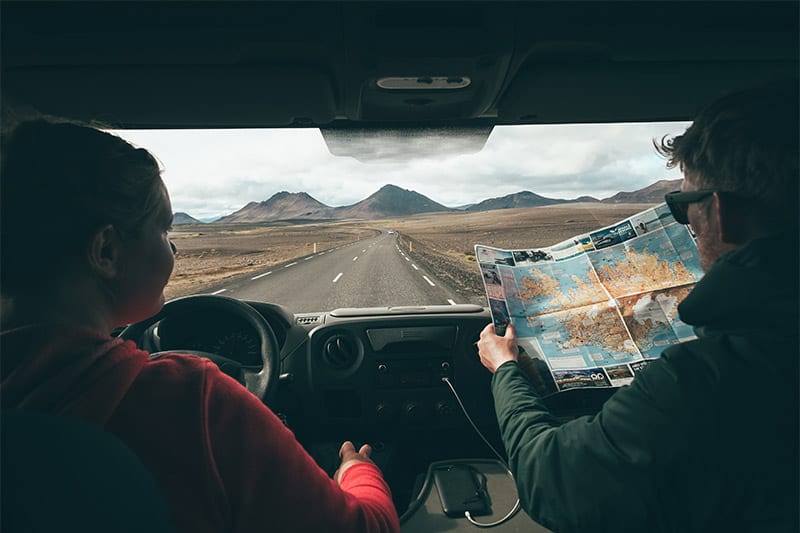
If you’re picturing a chilled cruise with waterfalls to your left and friendly puffins cheering you on from the right, you’re actually not too far off, but driving in Iceland does come with its quirks (and I don’t just me the potholes).
From sudden weather changes to gravel roads and the odd sheep traffic jam, it’s not your standard Sunday drive. But with a bit of preparation, a reliable van, and the ability to resist taking photos out the window at 90 km/h (or 56mph for team UK & US), you’ll be just fine.
Let’s look at the essentials to help you stay safe while soaking in the views.
Road Safety Basics
Driving in Iceland is generally safe, but it demands your attention. Pretty much all of the main roads are well-tarmacked and very well maintained year-round (which with our weather is a full-time job and some), but some roads off the likes of Route 1 can suddenly become gravel without warning (a very Icelandic attitude in general). The wind can also get spicy. And then there’s the weather, which treats forecasts more like suggestions.
Use common sense. Slow down when visibility drops. Definitely don’t tailgate like you’re a wannabe F1 driver. And, always ensure you keep your headlights on no matter the season to avoid breaking the law (and waking up a police officer).
What Makes Icelandic Roads Unique
One-lane bridges. Blind hills. Sheep with no sense of urgency. And road signs that sometimes look like they were designed during a particularly avant-garde art class (the latter just my interpretation).
If you’re planning a more rustic adventure in summer, you’ll also likely get to experience some F-roads. These are highland roads that are only open in summer and require a 4×4. Not a 4×2. Not a Fiat Panda. A real 4×4. Fortunately, we have got you covered with our Happy 4×4, Happy 4×4 EX, and Happy 4×4 XL.
Essential Driving Rules in Iceland

Whether you’re here for five days or fifteen, there are a few road rules that are crucial to take note of. Iceland has some unique regulations and expectations when it comes to driving, and getting familiar with them before setting off can save you from fines, confusion, or worse, awkward conversations with an Icelandic version of Paul Blart out on the open road. Let’s run through what you need to know to keep things smooth and stress-free behind the wheel.
Speed Limits & Seatbelt Laws
Speeding in Iceland is frowned upon, and by frowned upon, I mean it’ll cost you a stern talking-to by a traffic officer and a fine you’ll spend some time googling the conversion to your home currency (spoiler: it’s expensive).
General speed limits are clearly signposted and enforced with radar cameras dotted around the country, particularly near towns and tunnels:
- Urban areas: 50 km/h (31mph) unless otherwise stated
- Rural gravel roads: 80 km/h (50mph) (and that’s in good conditions)
- Paved rural roads: 90 km/h max (56mph)
These are limits, not targets (Iðm mainly talking to my father here). Road conditions often call for driving slower, especially with changing weather, poor visibility, or high winds.
Seatbelts are mandatory for everyone in the vehicle. Front seat, back seat, middle seat, even if you’re parked on a fjord with no one in sight. No exceptions. Not even for your inflatable travel buddy or your sulky teenager who thinks rules are optional (probably after they’ve told you you don’t understand them).
Failure to buckle up or stick to the speed limit could lead to heavy fines, deducted automatically from your rental agreement. So, it’s worth taking seriously, even if you’re running late on your itinerary, or you believe the last car that overtook was engaging in come form of rally race.
Headlights, Phones & Alcohol
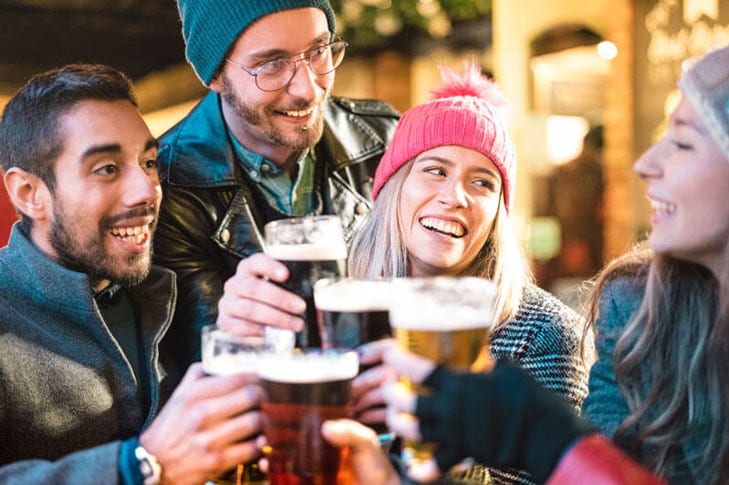
Headlights must be on at all times. Yes, even during the Midnight Sun. It’s the law.
Mobile phone use while driving is banned unless using a hands-free system. All our Happy Campers fleet have bluetooth for phone connection which is both handy, and saves you from investing in one of those horribly annoying ear pieces.
Drink driving is also strictly forbidden. Iceland has a near-zero tolerance policy. One beer can land you a fine and a complete ban, so leave the drinking to the passengers (just not the sulky teenager).
Renting a Campervan or Car
This is the part where the adventure really begins. Choosing the right vehicle is like choosing the right partner. Having selected the wrong partner/vehicle too many times, I know well that it can make or break the vibe (I mean trip).
Iceland offers everything from compact cars for city slickers to fully equipped campervans built for vanlife roadsters. But with all that choice comes a few questions, and we’re here to help you answer them before you’re standing in front of a rental desk trying to remember what a gravel road is (simply crappy roads).
Campervan vs Car: What’s Best for You?
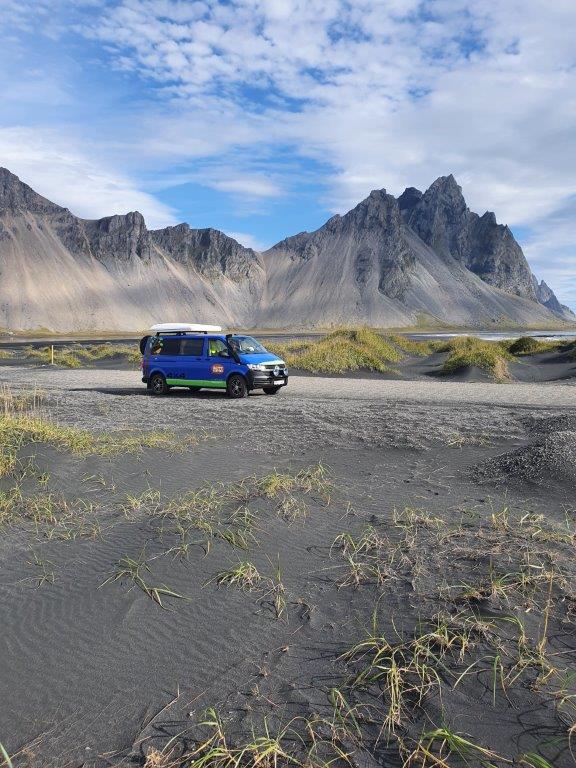
Short answer? A campervan.
Long answer? A campervan gives you accommodation and transport in one, which is priceless in Iceland where hotel prices can make your wallet beg for mercy. But it’s not just about saving money, it’s about waking up next to an iconic spot to immerse yourself in the country in a way more fun and flexible way, cooking breakfast beside a waterfall, and never having to repack your bags because your bed is always within reach. If you’re good at managing domestics, then I highly recommend the campervan option.
You get the flexibility to chase the good weather, detour on a whim, or stay an extra night in that quiet fjord you stumbled across which I obviously forgot to mention in one of the travel guides (sorry!)
If you’re planning on heading into the Highlands, you’ll need a Happy 4×4 at a minimum. These rugged machines are designed for the wild terrain and unpredictable roads you’ll face away from Route 1. With these beast you can confidently navigate the trial and tribulations on the gravel roads and brave the river crossings like a pro.
Insurance, Fuel, and Rental Tips
With Happy Campers, as standard, every rental has both Collission Damage Waiver (CDW) and Third Party Liability insurance included, but that doesn’t mean we don’t recommend a few extras for peace of mind based on the kind of trip you have planned.
If you’re planning on heading into the Highlands, always get gravel protection. Also Sand & Ash insurance can also be a valuable investment worth considering too, as one particularly breezy day near a volcanic plain can do more damage than you’d expect (nto quite the same as Peter Griffin’s Volcano insurance, I migth add).
To make thing easier, we have a specific guide on which insurance options are most suitable for you, as well as offering a series of packages to keep things simple, succinct, and you well away from the risk of more Googling of currency conversions.
Oh, by the way, fuel is expensive and sometimes sparse, so fill up when you can. The next pump might be three fjords away. Especially in the Westfjords and East fjords, it pays to think of petrol stations like sightings of rare birds: exciting, helpful, and not something to ignore when they appear (sadly rare birds won’t have petrol or diesel, I asked ahead).
The Ring Road: Iceland’s Scenic Highway
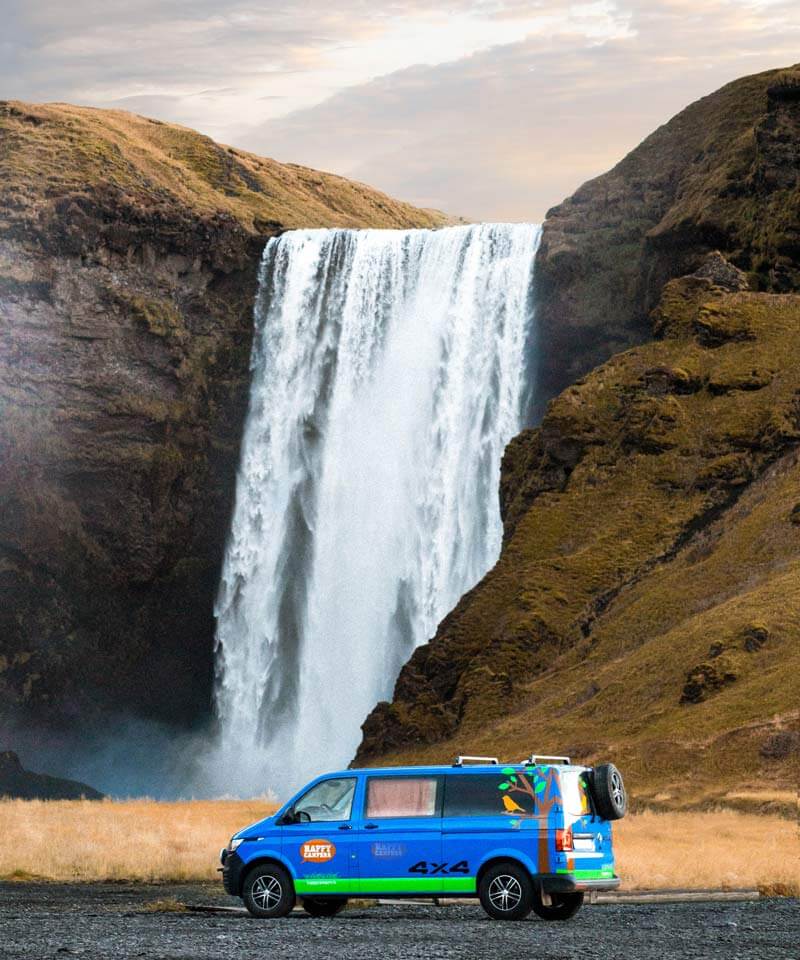
The Ring Road is the most travelled road in Iceland, but I’ll be honest, it’s a small country and there genuinely aren’t that many roads. This legendary loop stitches together the country’s most iconic sights with back-to-back scenery (particularly along the South Coast).
It’s also one of the best ways to explore Iceland at your own pace, whether you’re circling the entire island or just picking a stretch to dive into. Let’s break down what makes Route 1 so special and why your campervan will feel right at home on it (make sure to ask the team for our Ring Road playlist when you pick up your camper/Icelandic home on wheels).
What to Expect on Route 1
Route 1 (that’s the Ring Road, just in case I’ve been confusing you) circles the island in just over 1300 km/807 miles (for the Proclaimers, they’d need to do an extra 307 miles compared on top of their usual 500).
That might sound like a quick lap, but it connects a staggering variety of landscapes, that include glaciers, lava fields, black sand beaches, fjords, bubbling steam vents, waterfalls, volcanoes, and fishing villages all rolled into one giant scenic loop. Every hour brings something wildly different, and it’s not uncommon to stop five times before breakfast because you saw “just one more waterfall”, and wanted to blast TLC for the 11th time (sorry driver).
Allow at least 7 to 10 days for the full loop if you want to do it justice and not feel like you’re on a rally race with a camera (or my father – yes, he is still an awful speeding driver).
Use our Ring Road itinerary to plan the perfect route.
Key Stops Along the Way
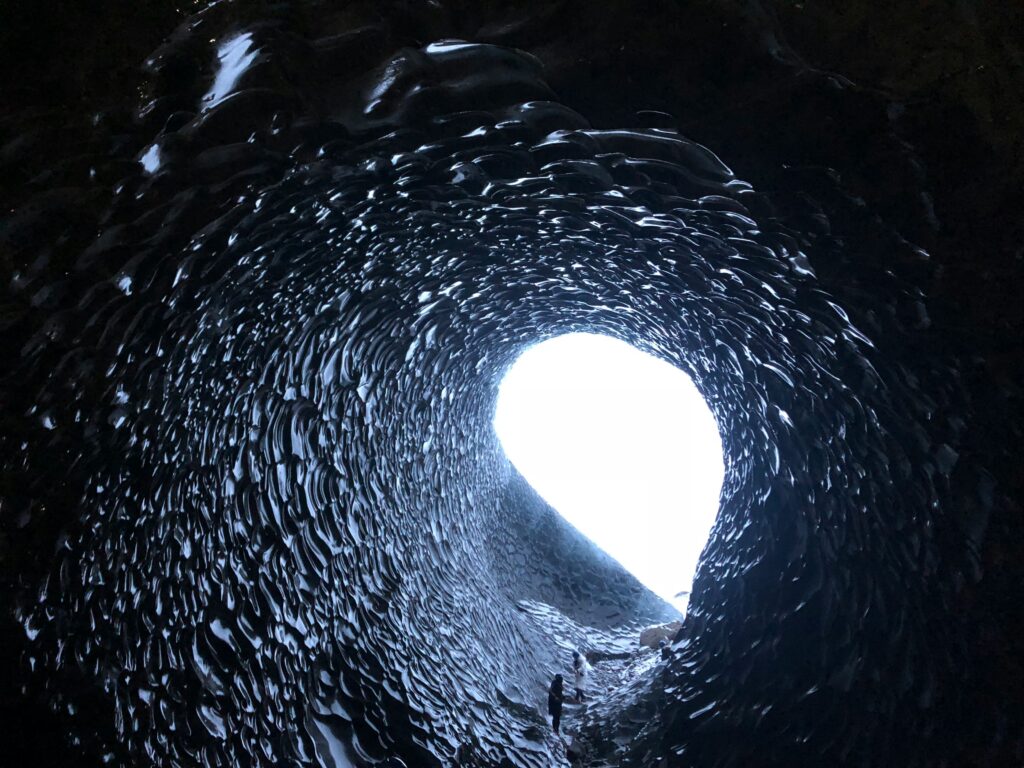
- South Coast: Skógafoss, Reynisfjara, and numerous options for a casual glacier hike or two (plus, Katla Ice Cave, and the Blue Ice Cave on the way)
- East Fjords: sleepy fishing villages, winding coastal roads, and the chance to see reindeer casually crossing your path that can pose remarkably similar to the Abbey Road album cover (with the God complex)
- North Iceland: whale watching in Húsavík, geothermal hotspots, and the cinematic beauty of Lake Mývatn
- West Iceland: Snæfellsnes Peninsula and Kirkjufell, often dubbed the most photographed mountain in Iceland, known well for it’s arrowhead-edness from Game of Thrones
Explore our Ring Road highlights for more inspo and secret stops worth the detour.
Paved vs Gravel Sections
Most of the Ring Road is paved. But some detours and shortcuts host some hearty gravel roads, and not the smooth, driveway-kind either. We’re talking proper, pothole-potential, tooth-rattling gravel that can surprise even confident drivers that many a time has inspired me to consider a pothole dodging phone app.
On these sections, traction can shift quickly, braking takes longer, and sharp stones can bounce up if you’re driving too fast, potentially chipping your windscreen or damaging your tyres. That’s why keeping your speed down might save you more than just one hefty bill.
Keep both hands on the wheel, drive defensively, and if you’re unsure about a stretch of road ahead, it’s always better to slow down and assess rather than wing it. Oh, and remember: off-roading is illegal. Seriously, there are no Jeremey Clarkson style Top Gear specials here for a reason. We’ll get to that shortly.
Weather & Road Conditions
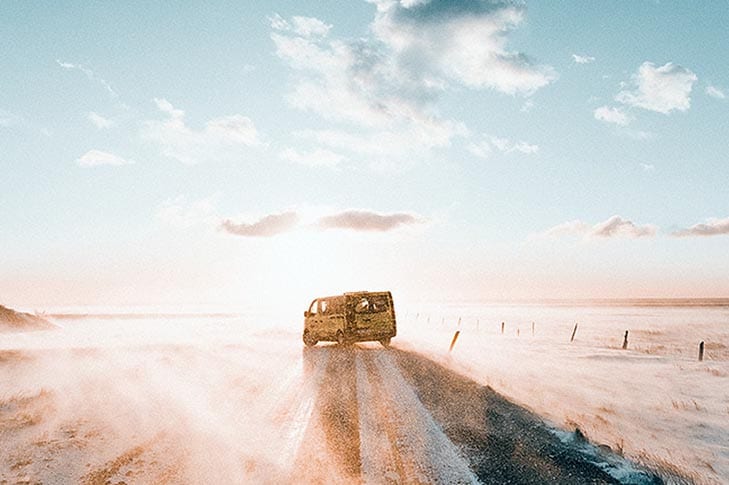
Let’s talk about the stuff that can flip your perfect road trip plan on its head. Iceland is famous for its moody skies and dramatic shifts in weather, which, depending on your timing, can either make you feel like a true adventurer or a very damp, slightly confused tourist (I’ve been both). From slick mountain passes to gale-force winds that can put an extra bit of hair on your chest, it pays to know what you’re driving into on the daily.
How to Check Daily Road & Weather Updates
The weather in Iceland changes faster than you can say “wait, which website did Chris tell me to monitor for weather alerts?” One minute it’s sunny, the next you’re in a snow flurry with visibility reduced to the length of a horse, sheep, or none at all in some instances. That’s why checking updates isn’t simply a nice-to-have; it’s a non-negotiable.
Use these sites to stay safe and up to date:
- SafeTravel for travel alerts, emergency info, and to log your trip.
- Vedur.is for real-time weather forecasts, storm warnings, and wind maps.
- Road.is for road closures, live cameras, and driving conditions.
Bookmark them, refresh them, live by them, maybe even dream of them. You’ll thank me later.
Driving in Summer vs Winter
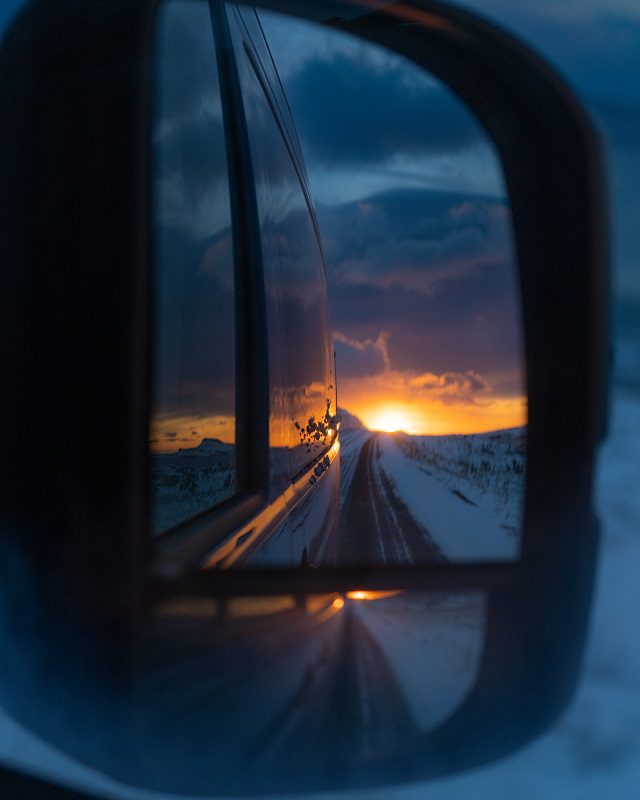
Summer = midnight sun, open highlands, and mostly clear roads.
This is prime campervan season, with long days that let you pack in waterfall soaks (I mean visits), glacier hikes, and late-night dips in hot springs without ever needing to check your watch. Campsites are buzzing, most roads are accessible, and the Highlands become your playground. Just remember, with the added freedom comes the need to book campsites early and prepare for busy viewpoints.
Winter = short days, snow, ice, and needing to know the difference between studded tyres and all-season tyres. Any other tyres and you’ll be slipping faster than Manchester United down the Premier League table.
But don’t let the chill scare you. Iceland in winter has a peaceful, cinematic quality. The Northern Lights might just dance over your camper, waterfalls freeze mid-cascade often displaying the function of a congested slushee machine, and the roads feel almost post-apocalyptic in the best way (more space, no zombies). You’ll need to adjust your plans and stay flexible with weather windows, but for those who are up for it, winter travel is like having the island (almost) to yourself.
We wrote a full guide on winter camping in Iceland.
Ice, Wind, Fog, and How to Handle Them
Slow down (in a nutshell, this is all you need to know).
If the wind is howling or visibility is poor, pull over safely and wait it out. Icelandic weather is not to be wrestled with. Crosswinds can be strong enough to knock over high-sided vehicles, slam car doors backwards, or make driving in a straight line a bit of a workout.
Fog, snow squalls, and sideways rain can appear without warning, reducing visibility to just a few metres. If you can’t see beyond your bonnet, it’s usually time to take a break and let nature do its thing, especially with whiteouts that can be very disconcerting. However, if you’re on the road and are struggling for visibility, simply slow down and try to follow the fluorescent road poles on the side of the roa, which should appear, even in the most dramatic conditions.
Always keep an eye on other vehicles, too. If locals are pulling over, that’s your cue. Safety first, photos second, trying to copy Vin Diesel driving from the Fast & Furious franchise never.
Highland Roads & Off-Road Rules
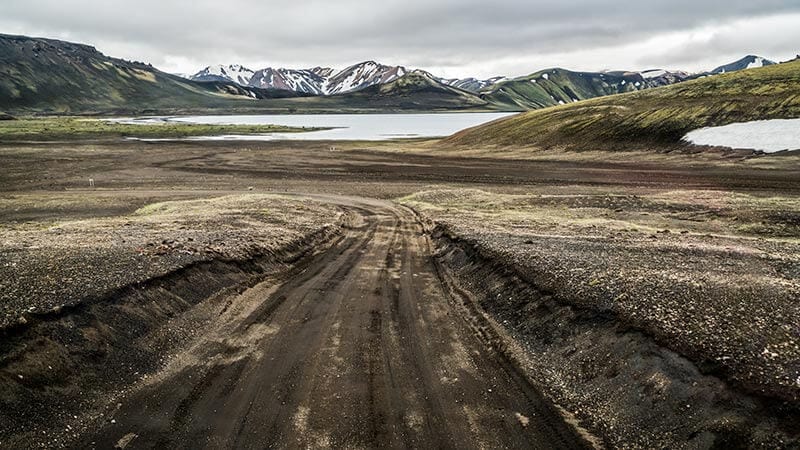
If the Ring Road is Iceland’s welcome mat, the Highlands are its secret stash of treasures. Rugged, raw, and often completely deserted, this is where Iceland’s nature goes up a notch with a much fuller immersion experience, away from tarmac, towns, and food halls.
But there’s a catch: not every road is created equal, and not every campervan is built for these wilder paths. This section is all about what you need to know before you even think about taking that tempting turn onto an F-road.
When You Need a 4×4
Any time you’re heading into the Highlands, a 4×4 is legally required and practically essential (unless you enjoy awkward calls to our team and the emergency services).
These areas are remote, rugged, and often unmaintained, with steep inclines, deep ruts, and river crossings that would laugh in the face of a regular vehicle.
The “F” in front of a road number is Iceland’s subtle way of saying: turn back unless your vehicle is ready to wrestle with nature better than the WWE Undertaker.
At a minimum, hire a Happy 4×4 if you want to explore routes like Landmannalaugar or Askja, which, trust me, if you’re visiting in summer, are two locations you won’t want to miss.
F-Roads and River Crossings
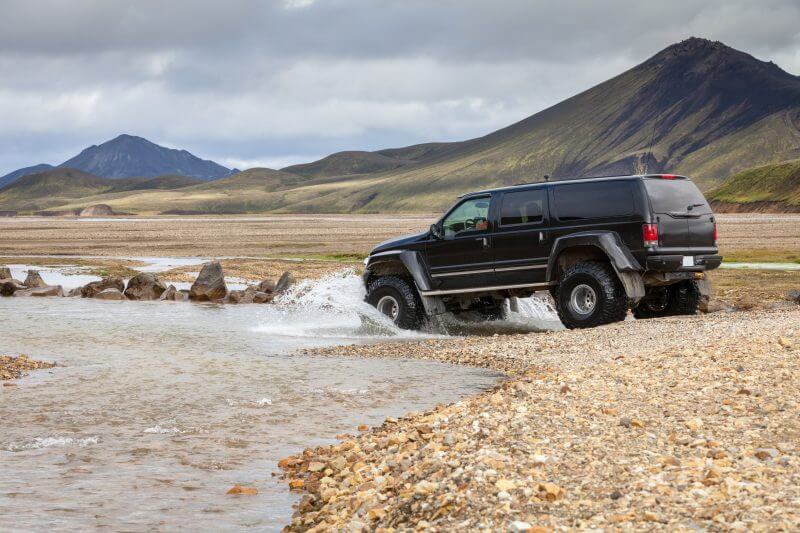
These aren’t your average puddles.
River crossings can be deep, cold, and occasionally a bit terrifying. Even if a vehicle ahead makes it through, conditions can change rapidly, and water levels can rise within hours after rainfall or glacier melt. Some rivers are glacial, meaning they can be murky and fast-flowing, making it harder to judge depth or obstacles underneath.
Before attempting a crossing, step out (carefully), assess the current, and always cross slowly in low gear. Avoid changing direction mid-stream, and never attempt it alone if you’re unsure. If you’re not 100 percent confident, turn around. There is no shame in choosing safety.
There are always signs before each crossing to give clear guidance on what to do, such as the best route possible across to ensure you don’t join a natural flume ride down the river.
Why Off-Roading Is Illegal (and Dangerous!)
Driving off marked roads damages the fragile nature and leaves scars that can last for decades. The volcanic soil and delicate moss can take hundreds of years to recover, and what might feel like harmless fun in a remote spot can have a lasting impact on this well-maintained ecosystem. Yes, really.
It’s illegal and comes with huge fines (yes, again). Plus, you’ll look like a bit of a muppet and probably end up on a very unflattering tourist-shaming Facebook page (mugshot: optional).
Stick to the roads. Respect the land. If you really want to get off the beaten path, that’s what hiking boots are for.
Parking in Reykjavík (and Beyond)
Let’s be honest, parking isn’t the most exciting part of any road trip, but it’s one of those necessary evils you’ll want to understand before your wheels hit the capital and the great enemy (traffic wardens) give you a wake up call with a 3000kr fine (I live here, and I’ve been fined for ridiculous things directly outside my flat window despite having a permit).
Reykjavík has its own system of zones, rules, and fines that can turn your Icelandic dream into a frustrating lesson in street signage if you’re not prepared.
This section will help you avoid the common pitfalls and find the best spots to safely park up without causing chaos, obstructing angry bus drivers, or collecting tickets.
How Parking Zones Work
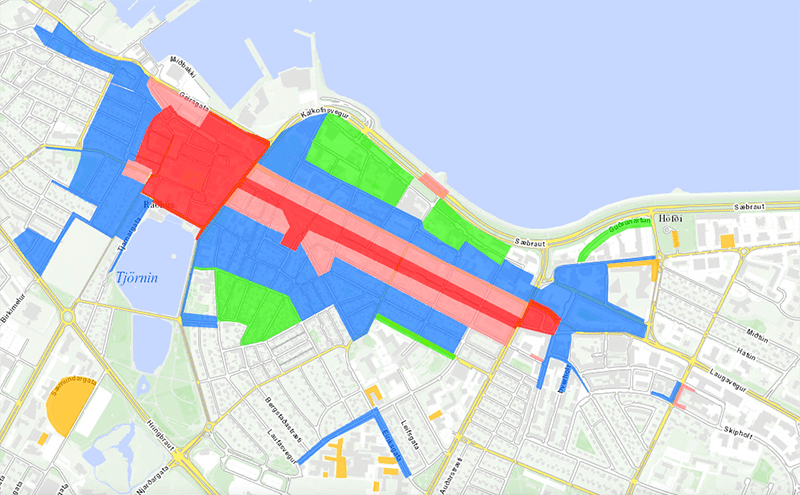
In Reykjavík, zones are colour-coded.
Red and pink are the most expensive, then blue and green. These zones are typically busiest in the city centre and around popular tourist spots, while the cheaper zones stretch a bit further out.
You can pay at machines or with apps like Parka and EasyPark (though I know setting up an app for a day or 2 days’ worth of parking is a bit of a faff). Just make sure to double-check the zone number before confirming your payment, mixing up your zones is a fast-track to an annoying ticket.
Most machines only accept card payments, which makes using the apps a far easier option for travellers, and much better if you’re an ultra planner and download these in advance.
See our Iceland parking guide for maps and insider tips on where to park stress-free.
Tips to Avoid Fines
Always check signs (I know, basic right?)
Parking rules can change between streets, and some areas switch to residential-only access in the evenings. Make sure you’re not in a bus zone, loading area, or blocking pedestrian paths.
Don’t overstay the meter. Don’t park like a tourist (sorry, there’s a bit of an unfair reputation). And don’t block any driveways, access roads, or electric charging stations unless you want an (un)friendly note or a not-so-friendly fine.
Or, as my dad would say, just don’t par like a d*ck.
Where to Park Your Campervan Overnight

You can’t sleep in your campervan in just an average car park (bit odd, also).
It might be tempting after a long drive to tuck into a quiet corner of a supermarket or a scenic viewpoint, but Icelandic law is very clear on this. Overnight stays are only allowed in approved areas with the proper facilities to handle waste and campervan traffic. Sleeping outside designated zones can lead to fines (I swear this is not my favourite word), complaints from locals, or even an early morning knock on your window.
Use designated campsites around Iceland, which are dotted all over the country and offer everything from basic amenities to hot showers and kitchen huts (and are generally fine proof, unless you ignore my Dad’s main driving tip above).
Even with all the planning in the world, Iceland likes to remind you who’s boss. And sometimes, that means a rogue snowstorm in July or finding yourself on a gravel track wondering where the last two hours went (maybe I just went the wrong way).
Luckily, there are digital tools and resources designed to keep you safe, informed, and on track, or at the very least, to help you figure out where you are when your surroundings start looking suspiciously like the set from Interstellar (alright, alright, alright).
Must-Have Apps for Road Trips
Before hitting the road, a few key apps can make all the difference between feeling confidently prepared and completely disoriented driving blind over a mountain pass.
SafeTravel is your lifeline for emergency alerts and trip registration. It’s run by Iceland’s search and rescue team, so they know what your plans are, and where you are if something goes sideways.
Veður gives you hourly updates on weather, wind, and the occasional storm system that decides to make landfall just to see if you read this guide thoroughly enough. You can filter by region, see wind maps, and check warnings with colourful symbols (or as I see it: Yellow – only go to the shop, Orange – it’s a Netflix day, Red – prepare for my neighbours flying outdoor furniture).
Parka is your go-to for paying parking fees around Reykjavík and other towns without scrambling for change. It’s also less stressful than deciphering signage mid-downpour.
Google Maps is, of course, your trusty navigator. But keep in mind that signal isn’t guaranteed everywhere, so download offline maps before you set off (a physical map and a compass may be a little overkill, Jack Sparrow).
And finally, keep the Happy Campers blog tab open in your browser. Yes, I know it’s a shameless plug, but it’s packed with travel guides, campsite tips, and answers to the kind of odd questions you’ll definitely end up wanting to Google or chatGPT along the way.
ICE-SAR’s GPS Safety App
Download 112 Iceland, register your trip, and you can send your location to emergency services with one tap, which is a great relief if you ever find yourself in some hairy situations.
The app works even with minimal mobile signal, which is a common reality once you veer off the main roads. It also allows you to check in along your route, giving rescue teams vital info if something goes wrong (or at least tracking data for a future Netflix documentary).
It’s simple, free, and takes less than five minutes to set up. In a country where nature calls the shots, it’s one of the smartest things you can do before heading out other than reading this guide.
Emergency Numbers and Resources
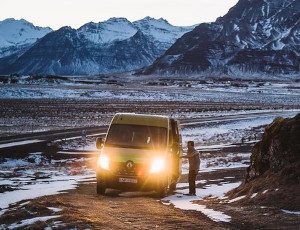
112 is the emergency number, but it will still work if you dial your own country’s emergency service number (including 911).
It connects you directly to Icelandic police, fire services, and medical responders, no matter where you are in the country. The system is reliable, fast, and designed to deal with everything from car accidents to hikers stuck in the Highlands, and sometimes even reporting drunk drivers on the road in front of you who like to pretend they are driving in the UK.
If you’re in trouble, call it. Even if you’re unsure whether it counts as an emergency, it’s better to be safe than sorry. The operators are trained to assess the situation and can guide you on what to do next. And yes, they’re also lovely people (but, even if you tell them that it won’t get you out of any of the fines I already warned you about).
Staying Focused Behind the Wheel
Let’s face it: driving in Iceland comes with a lot of wow-factor moments. From sudden geothermal valley visuals to flocks of birds dive-bombing your windscreen like it’s an action movie, it’s easy to forget you’re supposed to be driving. This section is all about keeping your eyes on the road, your hands on the wheel, and your snack stash within reach (our Happy Campers campervans were designed with this in mind, Commander, don’t you worry).
Dealing with Distractions (Scenery, Sheep, etc.)
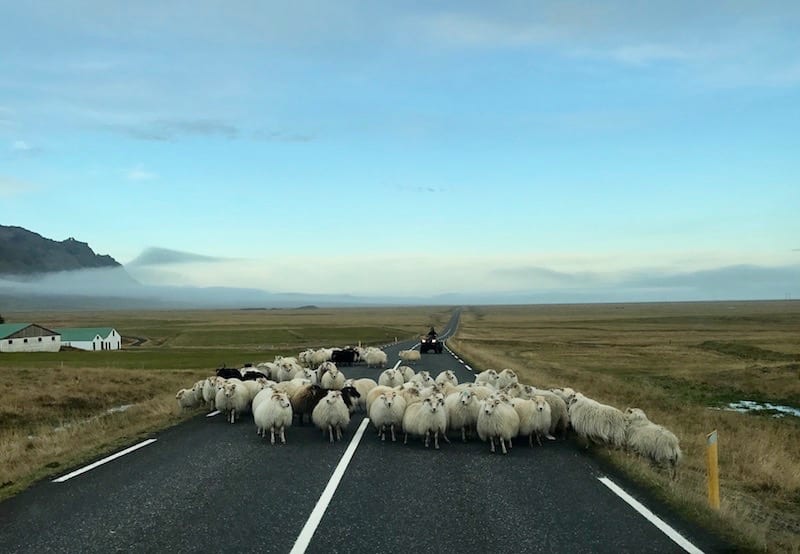
Yes, that waterfall is pretty wild and nuts, and all the other endless superlatives.
No, you shouldn’t take a photo while driving. And that includes attempting an artsy video with one hand while trying to steer through a bend with the other.
Iceland is bursting with distractions, from sunlit rainbows to cliffs that look like dragon spines, which may explain the level of ADHD cases in the country, come to think of it. It’s easy to get lost in the magic and forget you’re operating a big metal box. Pull over safely, admire the view, snap your shots, and then carry on.
As for sheep, they’re the ultimate wildcard. They appear without warning, often mid-argument with each other, and absolutely do not care about your braking distance (another app idea comes to mind). They have right of way, whether they deserve it or not, and honestly, they know it.
Avoiding Fatigue and Staying Alert
Iceland is bigger than it looks.
Distances may seem manageable on a map, but driving in Iceland takes longer than you might expect. What looks like a three-hour journey can easily stretch into five or more. Just because the population has barely reached 400,000 doesn’t mean everything is within a hop, skip, and jump’s distance.
Take regular breaks to stay alert and avoid fatigue. If you’re travelling with others, rotate drivers to share the load. And don’t fall into the trap of planning a minute-by-minute itinerary. Instead, give yourself breathing room to stop, enjoy, and soak it all in without feeling rushed.
Breaks, Snacks, and Scenic Pullovers
Always pack snacks. A hangry driver is a dangerous driver (if you also happen to be, well, me), especially when the next town is a long mountain pass away and all you’ve passed in the last hour are cliffs, rocks, and a whale you claim you saw breach when nobody else did.
Spectacular pullovers aren’t just a convenience; they’re very much part of the experience. Iceland practically begs you to slow down and breathe it all in. Take a moment to sip a coffee, watch the clouds roll over a glacial tongue, or just sit quietly while your Skýr chills naturally in the fresh Icelandic air. It’s these little pauses that turn a good road trip into an unforgettable one (assuming you remembered to pack the teenager).
Bonus Tips for a Smooth Campervan Journey
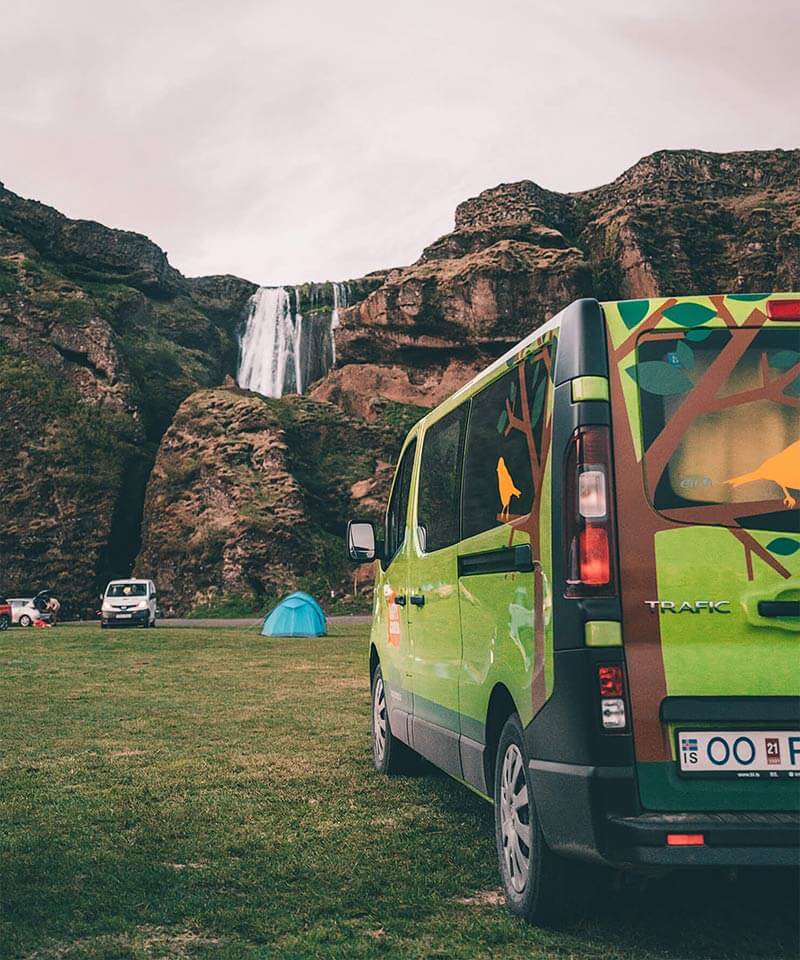
Even the most epic road trip can have its hiccups if you’re not prepped for the little things. That’s where these bonus tips come in. Think of them as the unsung heroes of your Iceland campervan adventure, offering small tweaks and smart moves that keep things easy, enjoyable, and maybe even social media-worthy (if that’s your thing).
Campsite Planning and Overnight Spots
I know I’ve mentioned it twice already, but three is the magic number: use our campsite map to explore hundreds of options across the country. Planning ahead is especially smart during summer months, when the most popular or centrally located campsites tend to fill up quickly.
In quieter times, spontaneity is more forgiving. But even then, it’s worth checking opening dates, facilities, and any seasonal restrictions to avoid showing up somewhere that’s closed or only offering the basics (e.g., a toilet, sink, and a patch of grass).
Fuelling Up and Restocking Supplies
Bónus and Krónan are your budget-friendly supermarkets, and you’ll find them in most larger towns across Iceland. They’re ideal for stocking up on staples like bread, pasta, Skýr (worth it), and that weird liquorice chocolate combo Icelanders seem to love (most tourists are not a fan, but the Icelanders are, so why not try it?)
Fill up on fuel in these larger towns too, as rural stations are fewer and far between. It’s smart to plan fuel stops around your overnight locations whenever possible. But remember, you do not need cash at all. Card payments are accepted across basically everything in Iceland, and fuel kiosks are no different.
Respecting Nature and Local Culture
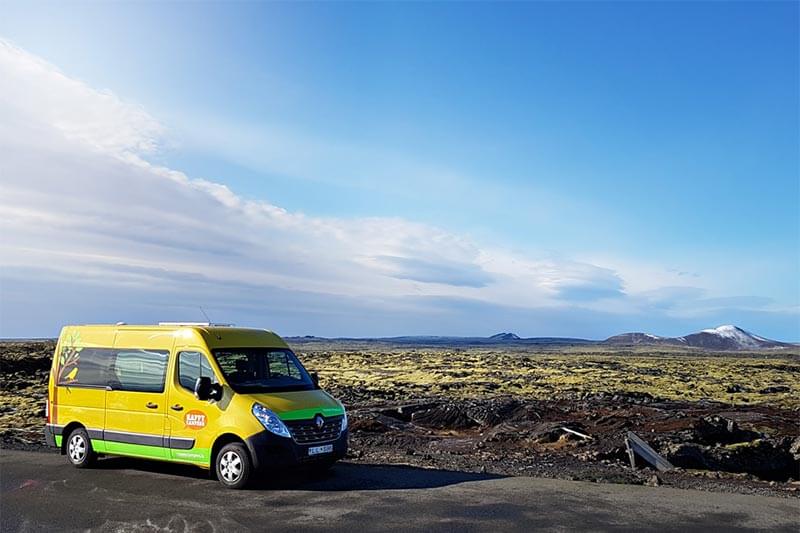
Don’t trample moss. Don’t litter. Don’t park like it’s your driveway back home. Iceland’s environment is uniquely fragile, and even a single careless move can leave lasting damage.
Respect the land by staying on marked paths and avoiding shortcuts across untouched terrain. Respect the people by being mindful of noise, following signage, and remembering that locals aren’t just part of the scenery; they live here. And respect the weather by knowing when to stay put, even if your itinerary says otherwise (all Icelanders and your campervan thank you).
Conclusion
Driving in Iceland isn’t just about getting from A to B, and it certainly isn’t a way to mimic Back to the Future speeds or Mario Kart competitions.
It’s about the unpredictable joy of the open road. About pulling over because the clouds did something weird, or because the landscape suddenly turned into something strangely and abruptly different. It’s about brewing your morning coffee with Skógafoss waterfall for a backdrop and ending the day watching steam rise from a hot spring as the Northern Lights start to wiggle across the sky.
There are few places on Earth that invite you to explore so freely, where the next wow moment is always just a turn away. With this guide, your van, and a spirit of adventure, Iceland is yours to explore. After all, if you treat Iceland right, she’ll treat you right.
Check out our campervans and let the journey begin.
Back